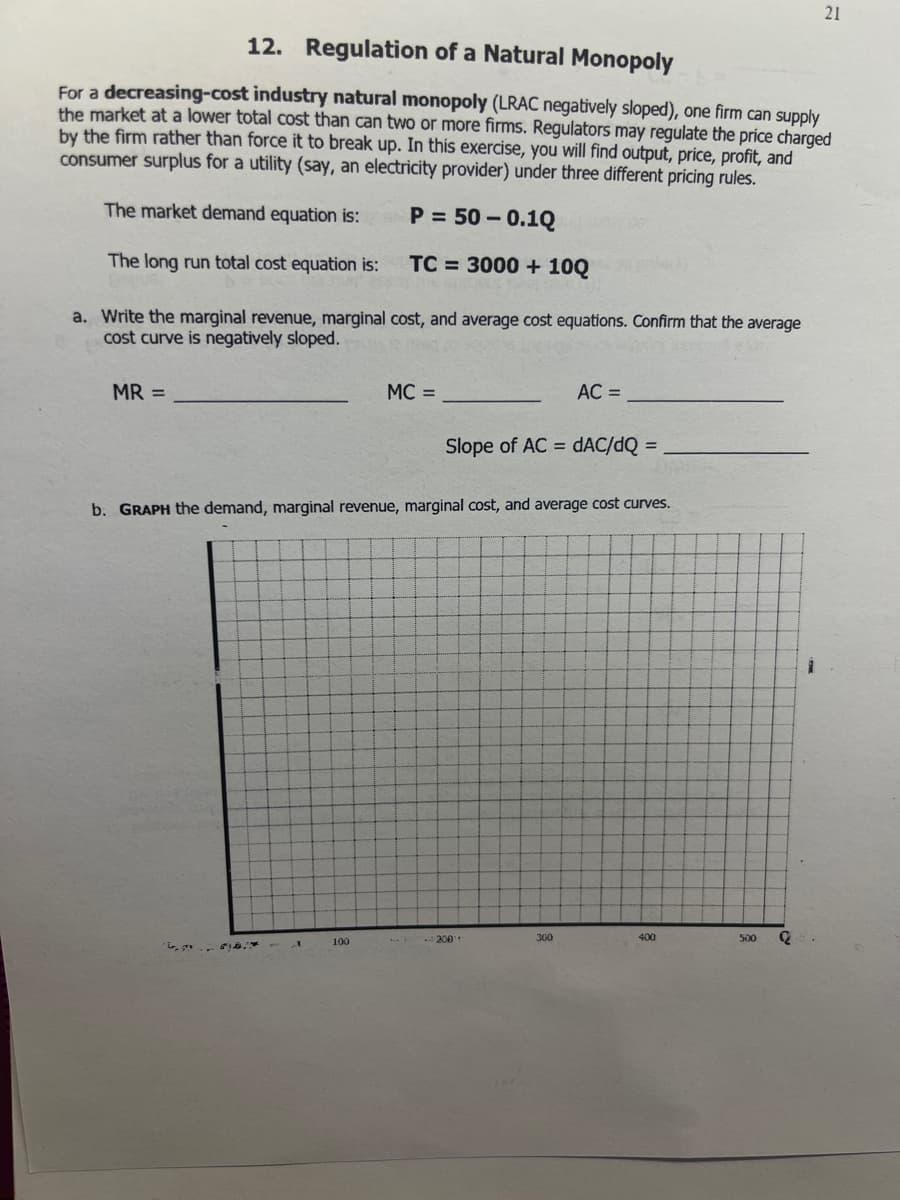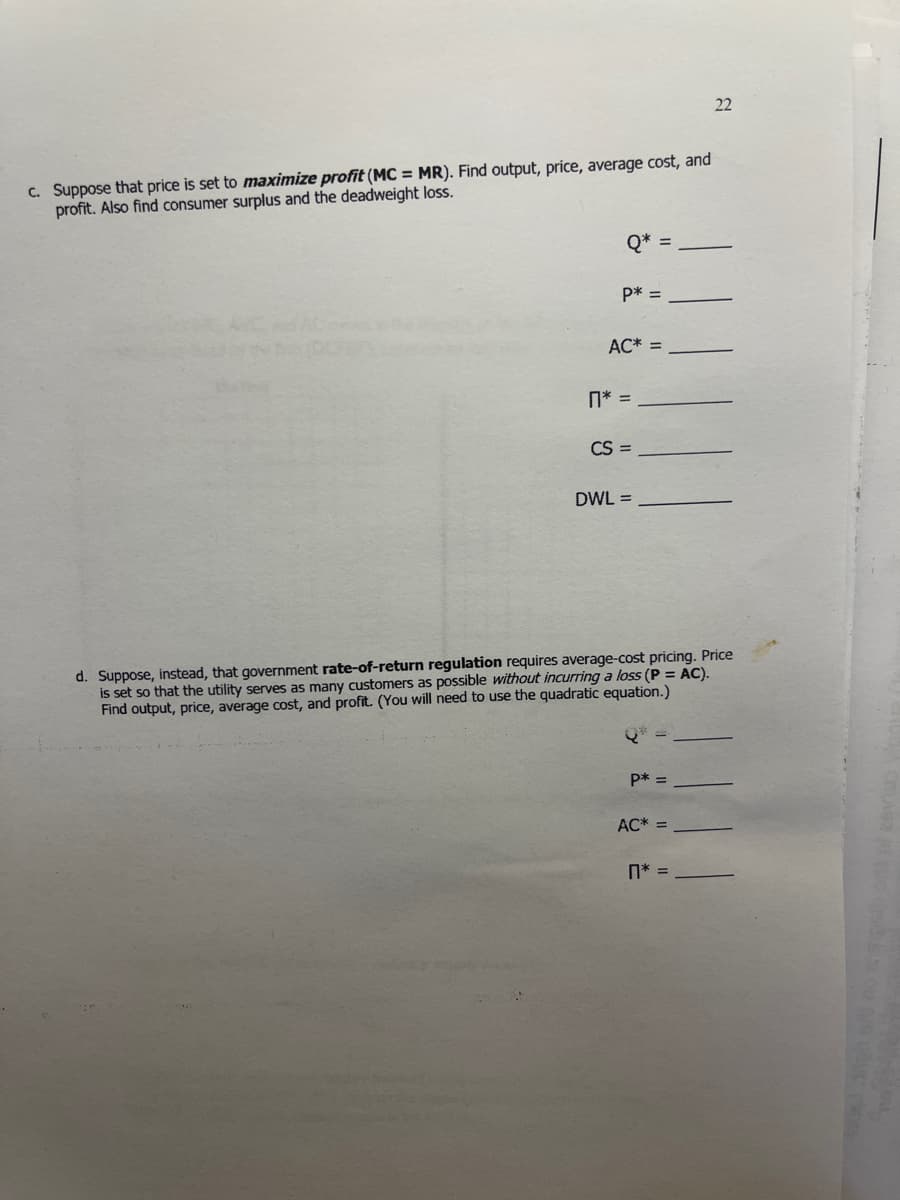12. Regulation of a Natural Monopoly For a decreasing-cost industry natural monopoly (LRAC negatively sloped), one firm can supply the market at a lower total cost than can two or more firms. Regulators may regulate the price charged by the firm rather than force it to break up. In this exercise, you will find output, price, profit, and consumer surplus for a utility (say, an electricity provider) under three different pricing rules. The market demand equation is: P = 50 – 0.1Q The long run total cost equation is: TC = 3000 + 10Q a. Write the marginal revenue, marginal cost, and average cost equations. Confirm that the average cost curve is negatively sloped. MR = MC = AC = Slope of AC = dAC/dQ = b. GRAPH the demand, marginal revenue, marginal cost, and average cost curves. 100 200 300 400 500
12. Regulation of a Natural Monopoly For a decreasing-cost industry natural monopoly (LRAC negatively sloped), one firm can supply the market at a lower total cost than can two or more firms. Regulators may regulate the price charged by the firm rather than force it to break up. In this exercise, you will find output, price, profit, and consumer surplus for a utility (say, an electricity provider) under three different pricing rules. The market demand equation is: P = 50 – 0.1Q The long run total cost equation is: TC = 3000 + 10Q a. Write the marginal revenue, marginal cost, and average cost equations. Confirm that the average cost curve is negatively sloped. MR = MC = AC = Slope of AC = dAC/dQ = b. GRAPH the demand, marginal revenue, marginal cost, and average cost curves. 100 200 300 400 500
Microeconomics A Contemporary Intro
10th Edition
ISBN:9781285635101
Author:MCEACHERN
Publisher:MCEACHERN
Chapter15: Economic Regulation And Antitrust Policy
Section: Chapter Questions
Problem 10PAE
Related questions
Question
Could I have help figuring out how to solve this problem?

Transcribed Image Text:21
12. Regulation of a Natural Monopoly
For a decreasing-cost industry natural monopoly (LRAC negatively sloped), one firm can supply
the market at a lower total cost than can two or more firms. Regulators may regulate the price charged
by the firm rather than force it to break up. In this exercise, you will find output, price, profit, and
consumer surplus for a utility (say, an electricity provider) under three different pricing rules.
The market demand equation is:
P = 50 – 0.1Q
The long run total cost equation is:
TC = 3000 + 10Q
a. Write the marginal revenue, marginal cost, and average cost equations. Confirm that the average
cost curve is negatively sloped.
MR =
MC =
AC =
Slope of AC = dAC/dQ =
b. GRAPH the demand, marginal revenue, marginal cost, and average cost curves.
100
200
300
400
500

Transcribed Image Text:22
C. Suppose that price is set to maximize profit (MC = MR). Find output, price, average cost, and
profit. Also find consumer surplus and the deadweight loss.
Q* =
p* =
AC* =
n* =
CS =
DWL =
d. Suppose, instead, that government rate-of-return regulation requires average-cost pricing. Price
is set so that the utility serves as many customers as possible without incurring a loss (P = AC).
Find output, price, average cost, and profit. (You will need to use the quadratic equation.)
P* =
AC* =
n* =
Expert Solution
This question has been solved!
Explore an expertly crafted, step-by-step solution for a thorough understanding of key concepts.
This is a popular solution!
Trending now
This is a popular solution!
Step by step
Solved in 4 steps with 1 images

Knowledge Booster
Learn more about
Need a deep-dive on the concept behind this application? Look no further. Learn more about this topic, economics and related others by exploring similar questions and additional content below.Recommended textbooks for you



Principles of Economics, 7th Edition (MindTap Cou…
Economics
ISBN:
9781285165875
Author:
N. Gregory Mankiw
Publisher:
Cengage Learning



Principles of Economics, 7th Edition (MindTap Cou…
Economics
ISBN:
9781285165875
Author:
N. Gregory Mankiw
Publisher:
Cengage Learning

Principles of Economics (MindTap Course List)
Economics
ISBN:
9781305585126
Author:
N. Gregory Mankiw
Publisher:
Cengage Learning

Principles of Microeconomics (MindTap Course List)
Economics
ISBN:
9781305971493
Author:
N. Gregory Mankiw
Publisher:
Cengage Learning

Essentials of Economics (MindTap Course List)
Economics
ISBN:
9781337091992
Author:
N. Gregory Mankiw
Publisher:
Cengage Learning